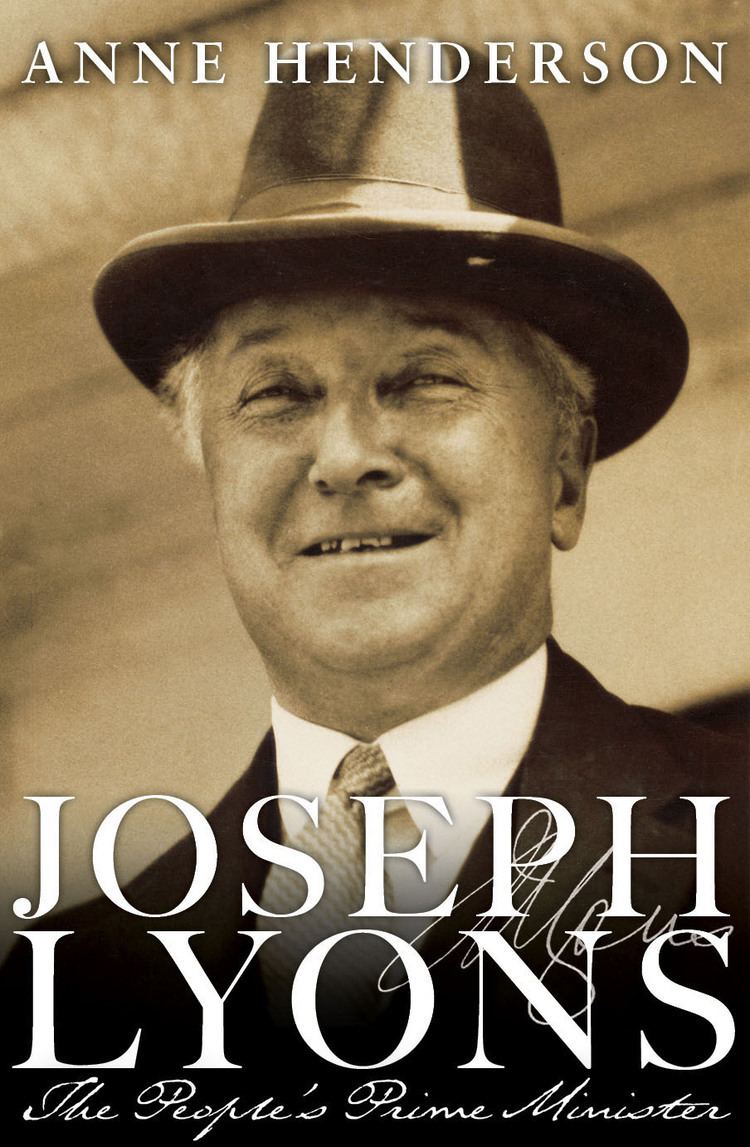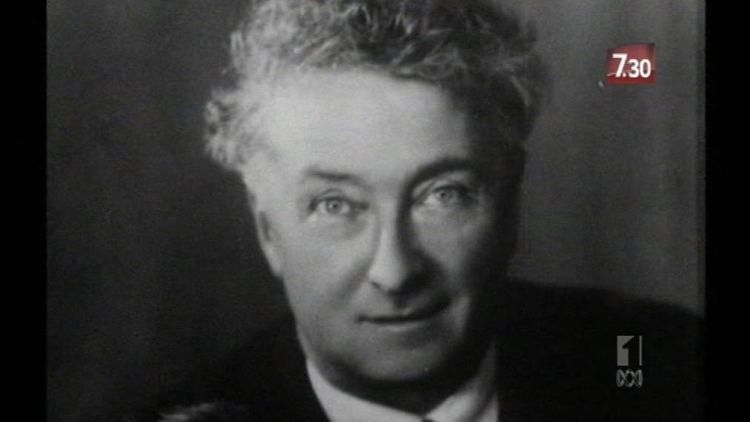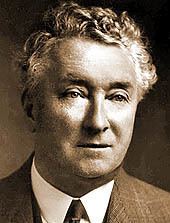Name Joseph Lyons Preceded by Position Established | ||
 | ||
Monarch George VEdward VIIIGeorge VI Governor-General Sir Isaac IsaacsLord Gowrie Deputy John LathamGeorge PearceEarle Page Deputy John LathamGeorge PearceRobert Menzies Died April 7, 1939, Sydney, Australia Education Philip Smith Teachers' Training College Children Kevin Lyons, Brendan Lyons, Janice Lyons Similar People | ||
Forgotten prime minister remembered in book
Joseph Aloysius Lyons, (15 September 1879 – 7 April 1939) was the tenth Prime Minister of Australia, serving from January 1932 until his death. He had earlier served as Premier of Tasmania from 1923 to 1928, and was the first, and to date only, prime minister from Tasmania.
Contents
- Forgotten prime minister remembered in book
- Early life
- State politics
- Federal politics
- Resignation from the Labor Party
- Prime Minister
- Death
- Legacy
- Honours
- References

Lyons was born in Stanley, Tasmania, and was a schoolteacher and trade unionist before entering politics. He was elected to the Tasmanian House of Assembly in 1909, representing the Labor Party, and became a government minister in 1914, under John Earle. Lyons was elected party leader after the Labor government's defeat at the 1916 state election. He became premier in October 1923, after Walter Lee lost a no-confidence motion, and served until being defeated at the 1928 state election. He afterward entered federal politics.

Elected to the Division of Wilmot at the 1929 federal election, Lyons was immediately made a minister in the new government formed by James Scullin. However, he resigned from cabinet in January 1931 over a policy dispute, and two months later left the party altogether. He and several other Labor defectors subsequently helped to form the new United Australia Party (UAP), which elected Lyons as its leader. The UAP won government at the 1931 federal election, and was re-elected in 1934 and 1937. Lyons died of a heart attack in April 1939, becoming the first prime minister to die in office. His widow, Enid Lyons, later became the first woman elected to the House of Representatives.

Early life

Lyons was born in Stanley, Tasmania, the grandson of Irish immigrants. His father, Michael Lyons, was a successful farmer who afterwards engaged in a butchery and bakery business, but lost this on account of bad health, and subsequently was forced to work as a labourer. His mother did much to keep the family of eight children together, but Joseph had to leave school at nine to work as a messenger and printer's devil. But with the assistance of two aunts, he was able to resume his education at the Philip Smith Teachers' Training College, Hobart, and became a teacher.[1] He also became an active trade unionist and was an early member of the Australian Labor Party in Tasmania.
State politics
In 1909 Lyons was elected to the Tasmanian House of Assembly for Wilmot in central Tasmania. From 1914 to 1916 he was Treasurer (finance minister) and Minister for Education and Railways in John Earle's state Labor government. As Education Minister he oversaw a number of reforms, including abolition of fees for state schools, improving teachers' pay and conditions, and founding Tasmania's first state high schools.
In 1913, a participant in the Labor discussion groups, Eliza Burnell, introduced him to her 15-year-old daughter, Enid Burnell, a trainee teacher and they were married two years later. She was a strong-minded woman who exercised great influence over Lyons, while raising their eleven children.
When the ALP split over conscription during the First World War in 1916, Earle, a pro-conscriptionist, followed Prime Minister Billy Hughes out of the Labor party. Like most Australians of Irish Catholic background, Lyons was an anti-conscriptionist and stayed in the Labor Party, becoming its new leader in Tasmania.
He led the Labor opposition in the Tasmanian Parliament until 1923 when he became Premier, leading a minority ALP government. He held office until 1928, also serving as Treasurer during the whole period of his premiership. Lyons' government was cautious and pragmatic, establishing good relations with business and the conservative government in Canberra, but attracting some criticism from unionists within his own party. Labor narrowly lost the 1928 state election to the Nationalist Party.
Federal politics
At the 1929 election, Lyons ran for the federal seat of Wilmot, covering the same territory as his state seat. He was swept into office in Labor's landslide victory under James Scullin. He was appointed Postmaster-General and Minister for Works and Railways.
When the Depression struck in 1930, the Scullin government split over its response. Lyons became the leading advocate within the government of orthodox finance and deflationary economic policies, and an opponent of the inflationary, proto-Keynesian policies of Treasurer Ted Theodore. Theodore was forced to resign over accusations of corruption in June 1930, and Scullin took over the Treasury portfolio in addition to the Prime Ministership. Lyons served as acting Treasurer from August 1930 to January 1931 while Scullin was in Britain for the Imperial Conference. In October 1930 Lyons announced his plan for recovery, insisting on the need to maintain a balanced budget and cut public spending and salaries, although also advising lower interest rates and the provision of greater credit for industry.
His conservative economic approach won him support among business, but angered many in the Labor caucus, who wanted to expand the deficit to stimulate the economy, and were horrified at the prospect of cuts in salaries and government spending. Alienated by their attacks, Lyons began to consider suggestions from a group of his new business supporters, including influential members of the Melbourne Establishment, that he leave the government to take over the leadership of the conservative opposition.
Resignation from the Labor Party
When Scullin returned in January 1931, he reappointed Theodore (as it had become clear Theodore would not be charged with corruption) to the Cabinet as Treasurer, which Lyons took as a rejection of his own policies. Lyons immediately resigned from the Cabinet, and then in March from the Labor Party. Accompanied by another senior minister in the Scullin government, James Fenton, and four other right-wing Labor MPs, he formed the "All for Australia League" and crossed the floor to sit on the opposition benches. Soon afterward, Lyons and his supporters joined with the opposition Nationalist Party and the Australian Party, a small party led by Hughes, to form a new party, the United Australia Party.
Although the UAP was essentially an enlarged Nationalist Party, Lyons was chosen as leader of the party. He thus became Leader of the Opposition, with former Nationalist leader John Latham as his deputy The UAP realised that Lyons, an affable family man with the common touch, was a far more electorally appealing figure than the aloof Latham. Additionally, his Labor background and his Catholicism would allow him to win traditional Labor constituencies (working-class voters and Irish Catholics) over to what was essentially an upper- and middle-class conservative party.
In March, at about the same time as Lyons led his group of defectors from the right of the Labor Party across the floor, 5 left-wing NSW Labor MPs, supporters of New South Wales Premier Jack Lang, also split from the official Labor Party over the government's economic policies (for Lyons they had been too radical, for the Langites they were not radical enough), forming a "Lang Labor" group on the cross-benches and costing the government its majority in the House of Representatives. Late in the year, the Langite MPs supported a UAP no-confidence motion and brought the government down, forcing an early election.
At the 1931 election, Lyons and the UAP offered stable, orthodox financial policies in response to what they branded as Scullin's poor stewardship of the economy. While Labor remained split between the official party and the Langites, the UAP projected an image of putting national unity above class conflict. The result was a huge victory for the UAP, which took 34 seats against 18 seats for the two wings of the Labor Party combined. The new government was sworn in January 1932. Lyons became the third former Labor MP (after Hughes and Joseph Cook) to become a non-Labor Prime Minister.
Prime Minister
The UAP fought the election in the traditional non-Labor Coalition with the Country Party (then led by Sir Earle Page). However, the massive swing to the UAP left it only four seats short of a majority in its own right, and Lyons' position was strong enough that he was able to govern alone during his first term. After the 1934 election resulted in the government's loss of eight seats, Lyons was forced to invite the Country Party into his government. Until 1935 Lyons served as treasurer as well as prime minister. In office, Lyons followed the same conservative financial policy he had advocated during the Scullin government, cutting public spending and debt. He benefited politically from the gradual worldwide recovery that took place after 1932.
As far as foreign policy was concerned, Lyons was a firm though by no means servile ally of Britain, and also supported the League of Nations. His government tended to support the conciliation of the dictatorships of Germany, Italy, and Japan to avoid another world war, but he still increased military spending. As a result, he ensured an expansion of the armed forces, the opening of an aircraft factory, and the planning of new munitions factories and shipyards.
At the 1934 election the ambitious and talented Robert Menzies entered Parliament, and was immediately seen as Lyons's successor, although he denied that he was seeking to displace Lyons.
The government won a third term at the 1937 election, with 44 of 74 seats and 50.6 percent of the two-party preferred vote against a reunited Labor Party led by John Curtin. As the international situation darkened in the late 1930s, Lyons, a long-term pacifist, became increasingly despondent. Most politicians expected that he would soon be replaced by Menzies, who resigned from Cabinet in protest at the government's inaction on the national insurance scheme.
Death
On 7 April 1939, in Darlinghurst, Sydney, Lyons died suddenly of a heart attack—the first Australian prime minister to die in office, he was buried in Devonport, Tasmania. He was 59 years old.
Legacy
Lyons was one of the most genuinely popular men to hold the office of prime minister, and his death caused widespread grief. His genial, laid-back appearance often led to cartoon portrayal as a sleepy koala. A devout Catholic, he was the second Catholic to become prime minister, after his immediate predecessor Scullin, and the only non-Labor Catholic prime minister until Tony Abbott.
Lyons is the only person in Australian history to have been prime minister, Premier of a State, and Leader of the Opposition in both the Federal Parliament and a State Parliament (although George Reid had served as premier of a colony before Federation). Lyons is also the only prime minister to come from Tasmania. At the time of his death, he was the second longest-serving prime minister in Australia's history, behind only Hughes.
Lyons was the only Australian prime minister to be in office during the reigns of three monarchs (George V, Edward VIII, and George VI), and the only Australian prime minister who was in office continuously throughout a monarch's entire reign (albeit a very short one, the 11 month-reign of Edward VIII).
Dame Enid Lyons later went into politics in her own right, in 1943 becoming the first woman to sit in the House of Representatives, and later the first woman Cabinet Minister in the Menzies' Liberal government. Two of their sons later became involved in Tasmanian state politics in the Liberal Party: Kevin Lyons was Deputy Premier between 1969 and 1972 and Brendan Lyons served in the ministry of Robin Gray during the 1980s.
Honours
In 1984, Lyons' old seat of Wilmot was renamed the Division of Lyons jointly in honour of Lyons and his widow Dame Enid Lyons. The state seat of Wilmot was also renamed Lyons for the same reason.
The Canberra suburb of Lyons, Australian Capital Territory is named in honour of Joseph Lyons.
In 1975 he was honoured on a postage stamp bearing his portrait issued by Australia Post.
